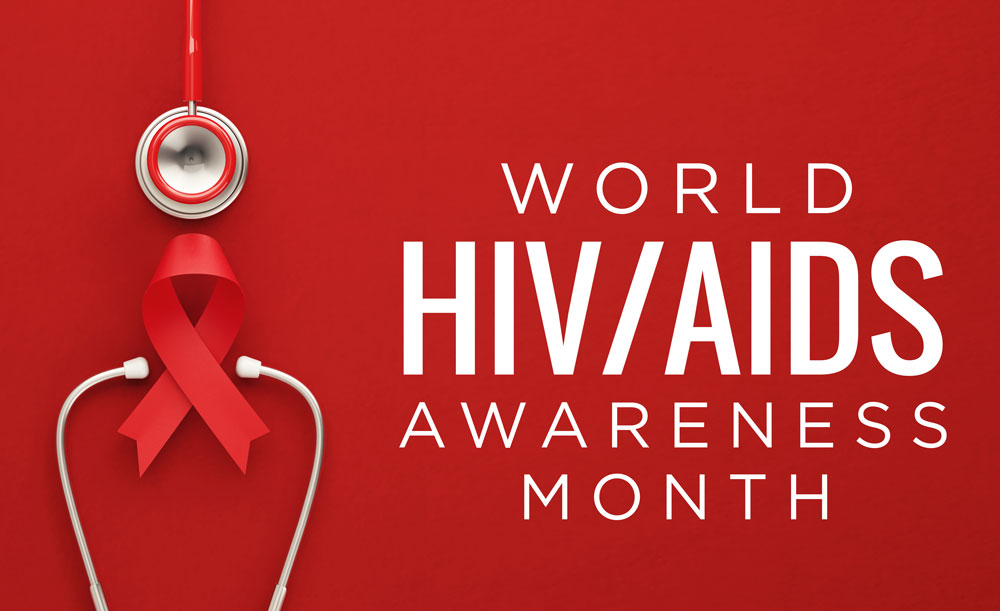An HCDI Healthy People 2030 Spotlight: World HIV/AIDS Awareness Month
The Significance of HIV Prevention, Testing, and Treatment to Improve Health Outcomes
By HCDI Communications
 December is World HIV/AIDS Awareness Month. During this month, we show support for people living with HIV/AIDS and encourage HIV testing for disease prevention and treatment. HIV, which stands for Human Immunodeficiency Virus, weakens a person’s immune system by destroying vital cells that fight disease and infection. More than 1.2 million in the United States are living with HIV.
December is World HIV/AIDS Awareness Month. During this month, we show support for people living with HIV/AIDS and encourage HIV testing for disease prevention and treatment. HIV, which stands for Human Immunodeficiency Virus, weakens a person’s immune system by destroying vital cells that fight disease and infection. More than 1.2 million in the United States are living with HIV.
Common ways of HIV transmission include unprotected sex, sharing needles/syringes and drug injection equipment, and from a mother to her baby. Some groups of people are more likely to get HIV than others. Teens, young adults, and men who have sex with other men are at higher risk of getting STIs and likewise at a higher risk of getting HIV. In 2021, male-to-male sexual contact accounted for 67% (24,107) of all new HIV diagnoses while heterosexual contact accounted for 22% (8,059) of all HIV diagnoses. That same year, African Americans accounted for 40% (14,528) of all new HIV diagnoses while Hispanics/Latinos accounted for 29% (10,467) of all new HIV diagnoses. The population most affected is African American gay and bisexual men with 8,883 cases, followed by Hispanic/Latino gay and bisexual men with 8,000 cases in 2021.
While there is no cure for HIV, with proper medical care from a healthcare provider, the disease can be controlled. If left untreated, it can lead to AIDS (acquired immunodeficiency syndrome), where opportunistic infections (OIs) develop, like pneumonia, lymphoma, tuberculosis, cervical cancer, or wasting syndrome, or when CD4 cell count drops below 200 cells per milliliter of blood.
HIV Testing
For HIV prevention, the Centers for Disease Control and Prevention (CDC) recommend everyone 13 to 64 years old get tested. People with certain risk factors should get tested yearly. HIV tests are generally covered by health insurance without co-pay, as required by the Affordable Care Act. You can get tested by your healthcare provider, buy a self-test at a pharmacy, locate a testing site, or contact your local health department for free or low-cost HIV tests.
HIV Treatment
Once HIV is confirmed through testing, it is vital to consult with a doctor to begin treatment. Taking your HIV medicine reduces the amount of HIV in your system, enhances your immune systems and prevents drug resistance. The side effects of HIV treatment are similar to other shots and medicine, and include nausea and vomiting, diarrhea, difficulty sleeping, dry mouth, headache, rash, dizziness, fatigue, temporary pain at the injection site.
Healthy People 2030 Prevention and Treatment of STIs and HIV
Healthy People 2030 focuses on preventing and treating sexually transmitted infections (STIs), including HIV, and on improving the health and well-being of people who have them through measuring a series of related objectives.Concerning HIV prevention and treatment, Healthy People 2030 is finding little to no detectable changes in:
- Reducing the number of new HIV infections
- Increasing viral suppression
- The proportion of adolescents who get formal sex education
However, improvements have been made in:
- Reducing the number of new HIV diagnoses
- The rate of mother-to-child HIV transmission
- Increasing the linkage to HIV medical care
To continue to improve HIV prevention and treatment results, proper preventative care and health education for teens and young adults as well as pregnant mothers with HIV is critical. Promoting healthy behaviors like condom use and testing can improve health outcomes and prevent the spread of HIV to others.
| Objective | Most Recent | Baseline | Target | Status |
| Reduce the number of new HIV infections
|
34,800 persons
(2019)
|
37,000 people 13 years and older were newly infected with HIV (2017) | 3,000 people
|
Little to no detectable change |
| Increase viral suppression | 64.6% (2020) | 63.1% of people 13 years and older living with diagnosed HIV infection were virally suppressed (2017)
|
95.0% | Little to no detectable change |
| Increase the proportion of adolescents who get formal sex education before age 18 years | 54.5% (2017-19) | 52.8% of adolescents received formal instruction on delaying sex, birth control methods, HIV/AIDS prevention, and sexually transmitted diseases before they were 18 years old (2015-17)
|
59.1% | Little to no detectable change |
| Reduce the number of new HIV diagnoses
|
30,346 people
(2020) |
38,351 people 13 years and older were newly diagnosed with HIV (2017) | 3,835 people | Improving |
| Reduce the rate of mother-to-child HIV transmission
|
1.0 perinatally acquired HIV infections per 100,000 live births (2020)
|
1.3 perinatally acquired HIV infections per 100,000 live births
(2015)
|
0.9 per 100,000 live births
|
Improving |
| Increase linkage to HIV medical care
|
82.4%
(2020)
|
77.8% of people 13 years and older with newly diagnosed HIV infection were linked to HIV medical c care within 1 month of HIV diagnosis (2017) | 95.0% | Improving |
HCD International Conducts Outreach to Promote Healthy Behaviors
In our daily work engaging with health plans and residents, HCD International is committed to ensuring that our most vulnerable can get or have access to healthcare and social services resources. Through our culturally intelligent outreach, HCDI community health workers screen for Social Determinants of Health (SDoH) barriers and provide health education and resources for accessing health needs like healthy food, housing, mental health, HIV testing, and transportation for HIV treatment and preventative care.
To learn more about our health equity engagement services, visit hcdi.com or contact us directly at info@hcdi.com.
What is Healthy People 2030
Originating in 1979, the Healthy People initiative began when the United States Surgeon General Julius Richmond issued the “Healthy People: The Surgeon General’s Report on Health Promotion and Disease Prevention.” The mission of Healthy People 2030 is “to promote, strengthen, and evaluate the nation’s efforts to improve the health and well-being of all people” with a vision to cultivate a society where all people can achieve their full potential for health and well-being.
To learn more about Healthy People 2030, visit health.gov/healthypeople.






